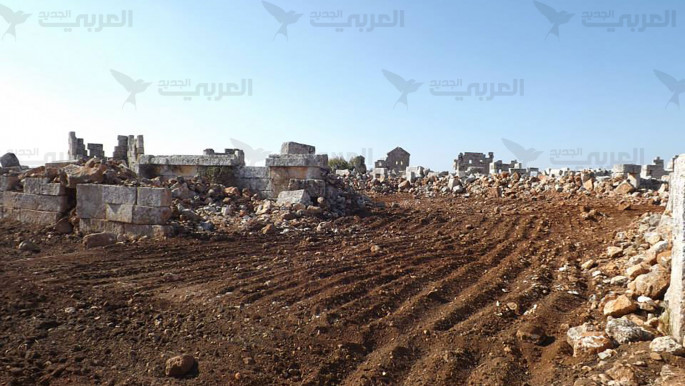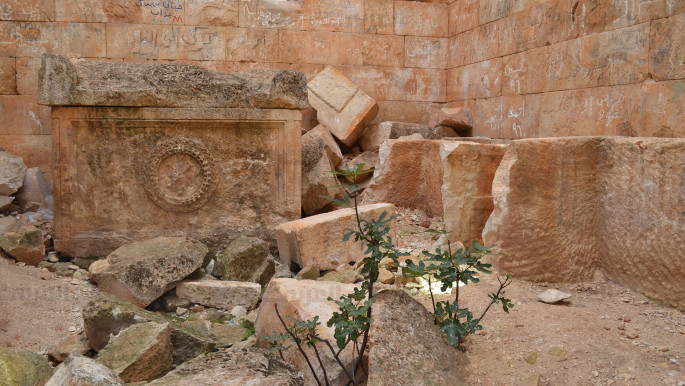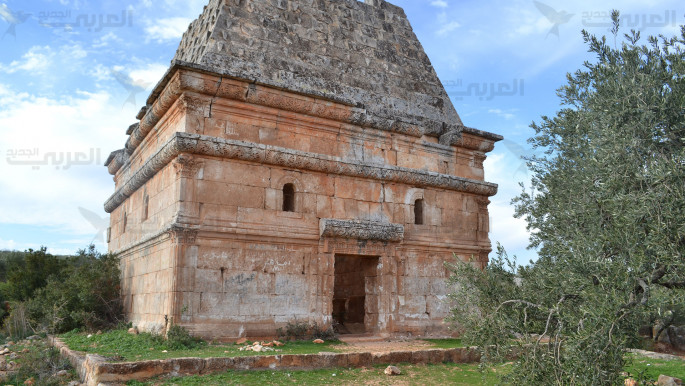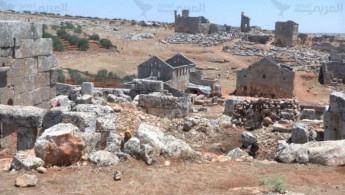Roman ruins become home for Syrian refugees
Little Marah did not expect to live in an ancient Roman town and play among the tombs of its long-dead residents. But then she didn't expect her house to be destroyed in the ongoing conflict in Syria either.
Having fled war, the ten-year-old now lives in a Roman castle that her family has adapted, and uses the nearby cemetary as her playground. But her salvation has come at the expense of Syria's cultural legacy.
This is Serjilla, a settlement founded in the 2nd century and one of Syria's 40 ancient "forgotten cities" of antiquity, whose history is being lost forever as refugee families move in and make better lives amid ancient ruins.
French historian George Tate, the director of the Franco-Syrian Archaeological Mission of North Syria from the mid-1990s to the mid-2000s, says Serjilla is considered one of the world's most important archeological sites.
Most of the 65 families now living here have changed the buildings. Serjilla's castle has been divided into several areas, with new internal concrete walls, windows and doors to house several familes.
Its royal baths and church have also been altered, and five ancient buildings have been demolished to make way for farmland near the area.
New businesses have been set up in the old Roman bath house - a barbershop, a grocery store and cafes.
| We do not have another choice. We cannot return to our destroyed homes. - Umm Morhaf |
According to Abu Salem, head of his family, the first castle in Serjilla has a large lounge, and this was divided into a reception area and several rooms matching the number of family members.
Another family created new rooms by building concrete walls inside the archaeological site, adding a layer of clay to the stone walls.
The walls of the fully intact Aramaic church in Serjilla were also daubed with clay. In this church there is a family who lost a father and a daughter to a missile launched by Syrian regime forces.
That tragedy pushed the survivors to move to the safety of these isolated ancient sites and renovate them to suit their needs, Umm Morhaf, a middle-aged mother, said.
"We added the clay to block the wind from seeping into the building where we live, because we do not have another choice. We cannot return to our destroyed homes because of the shelling," she explained.
These unprecedented renovations included breaking through walls to open new doors and closing existing ones to suit the families' needs. Badie Aboud's family opened a new door in the ancient house's front wall, facing the main road in the forgotten city of Shinshrah, an alteration that completely transformed the structure of the house.
Al-Bara: demolition and trade
In the ancient city of al-Bara, new residents broke into the royal tomb to sell its contents as antiques. The tomb had beautiful, unique ornaments. According to Tate, it was one of the most important royal tombs in the world.
 |
|
Monuments have been removed from some |
Unbroken stones from al-Bara's ancient ruins were being concreted together to build extensions.
In addition, we found that three tombs within the royal pyramid had been completely destroyed.
The revolutionary local council
"The municipality has spotted several violations of ancient sites in al-Bara and Serjilla," said Mamdouh al-Nasouh, head of the interim government's local council.
Violations range from shelling by the Syrian regime to refugee camps built within the ruins of Serjilla, where the walls have been distorted and stock rooftops and clay have been added to the ancient buildings.
"When we talked to the refugees, they said they had no other place to go, as their houses had been destroyed by shelling," Nasouh said.
About two kilometres away from Serjilla and other ancient towns, some families broke up a number of large stones and levelled buildings in an attempt to cultivate the land and produce food so they could eat.
Shinshrah
We noticed some changes in the archaeological site at Shinshrah, resulting from paving the roads within the site to connect the refugee camps. New residents have been breaking a large number of stones to build roads.
Treasure hunters also smashed up stones from ancient houses into smaller pieces to sell them without any supervision or control.
In March 2013, Unesco had to include these "Forgotten Cities" on its list of world heritage sites in danger. Five other Syrian archaeological sites were also added to the list - in Aleppo, Damascus, Bosra, Tadmur, and Saladin Castle. The decision came two years after they were first listed by Unesco.
Rami Diab, a young man in his 30s, lives with his family in an ancient castle after his house in the town of Kafroma, near Maarat al-Numan in the Idlib countryside, was destroyed by Syrian regime shelling.
The Byzantine castle, named Qasr al-Deir ("Monastery Castle"), is characterised by its beautiful architecture and fully intact structure, with carvings based on old manuscripts. Rami put plastic tables and chairs into the castle and turned it into a cafe to provide a "sanctuary for the youth".
What makes matters even worse is that residents cook and heat water using charcoal and firewood in and around the ancient buildings, and the heat from the fires is causing cracks in their walls and damaging them. We found cracks in many walls due to fires made in the stone of the houses and castles.
Residents of these world heritage sites do not have access to sanitation or clean water, either for drinking, bathing, and washing dishes and clothes. They use groundwater from Roman wells around the area, which endangers both them and the ancient buildings, as it could lead to subsidence and cracks in the building's foundations - or possibly exposing the residents to possible contamination of groundwater.
"Wastewater contains toxic substances, such as sulfates, nitrates and chlorides," said water toxicity expert Fadi al-Abd, from Maarat al-Numan. "When these substances seep into the soil, it will take a long period of time before the soil loses its toxicity.
 |
| Ancient walls have been smashed to sell fragments as antique souvenirs [alAraby] |
"The problem is that wastewater has seeped into the soil of these sites, and there are wells and surface water that people use for drinking water, which can cause diseases that we cannot deal with at this time. This water has also dissolved and damaged the stones in these archeological sites."
Locals have resorted to collecting water in wells due to the large number of refugees, but this has increased the dampness of the soil and caused the water table to rise.
"The studies conducted in the area have revealed the groundwater level in these sites is now around 20 metres below the monuments," Abd added.
Some residents have stopped using the groundwater and have started digging to install pipes, creating a makeshift water network for this new community. This digging has also had an impact on the monuments and has changed their appearance.
With the lack of alternatives, the local council cannot prevent refugees from living there, or from destroying the monuments and tombs.
"We do not have any forces or specialised committees to monitor the areas or prevent the refugees from destroying them," Nasouh complained.
Walid Salloum, a former archaeology professor at the university of Aleppo, lives nearby. "Making fires inside or around these areas will affect the heritage buildings. The historic value of ancient buildings lies in their original form. These fires can damage and obliterate the monuments," Salloum said.
Responsibility
Dr Taghrid al-Hajali is the minister for culture in the interim government.
He said the war and the inability to provide international protection for the heritage sites - empty of both tourists and staff - were the reason for their destruction.
| There are whole areas in danger of being destroyed and disappearing forever. - Taghrid al-Hajali, minister for culture |
"There are whole areas in danger of being destroyed and disappearing forever, such as the Palmyra Columns," said Hajali.
"There are also more than 15,000 other archaeological sites threatened by illegal digging.
"Syria's monuments belong to everyone. Syrian history has nothing to do with politics or militarisation. We have to protect these structures because future generations will not forgive us if we don't."
In times of war, the protection of antiquities is the responsibility of the authorities holding the territory. Currently the heritage cities fall under the joint jurisdiction of the Nusra Front and a number of anti-Assad factions.
Face to face with the Nusra Front
We went to the sharia court in Mount Zawiya, which manages the areas controlled by the Nusra Font and other factions, with the facts we had gathered over the past three months.
"Whenever any transgressions are reported, the locals are warned not to repeat them," said Abd al-Munaim Zain al-Din, the head of the court's security team. "We cannot constantly be present in these areas. But we do try to prevent locals from vandalising sites as much as possible.
"We would like to raise awareness of the importance of these sites and the need to preserve them as they are our country's heritage, but the war has forced everyone to commit transgressions."
He said he thought it was unlikely the problem could be easily solved by villagers returning to their homes. "This will not happen until the regime and its security apparatus are brought down," he said.
 |
| Fears linger for the remaining monuments [alAraby] |
Unesco
Nada al-Hassan, the head of Unesco's Arab Countries Division said that al-Bara was the first site to be damaged, when the regime's tanks ran through the site at the beginning of the uprising in March 2011.
"When locals squat in these sites and build toilets and kitchens, this will effect these monuments," she said. "But the biggest factor has been the war in these areas, not the people."
Unesco remains in communication with all sides in the Syrian conflict and is a neutral party, said Hassan - who knows all too well about the difficulty of communicating with groups such as the Nusra Front, and sending teams into areas outside the control of the Assad regime to tackle the problem.
Unesco has tried to organise training workshops in its Beirut office to coach experts and technicians on how to protect damaged sites, although participants from North Syria could not travel to Lebanon because of security reasons.
Hassan added that Unesco was attempting to engage with civil society groups and prominent figures to help protect the monuments: "We are interested in protecting these sites. According to the Geneva Conventions and the laws regarding this subject, we are entitled to work with all sides of the conflict to protect these areas."
It is difficult to estimate the costs of restoring the monuments in north Syria, as experts have not been able to visit the areas to calculate the damage.
"Some things cannot be restored, especially when they are damaged by shelling or deliberate vandalism," said Hassan.
"I think the total amount of destruction in Syria is comparable to the Second World War, especially in Aleppo, Homs and Idlib. If we want to restore an archaeological site such as al-Bara, it needs a lot of funding - in addition to experts, archaeologists and conservationists, because the work is very precise."
Unesco-suggested safe zones
Unesco is dealing with Syrian heritage sites and antiquities in several ways. It has suggested the United Nations Special Envoy to Syria Staffan de Mistura and his team could be the neutral party to enter these areas and communicate with technicians and train them how to protect and maintain sites.
The head of Unesco has also asked the UN to raise awareness among member states about the importance of preserving heritage sites.
The past three years have seen refugees appropriate archaeological sites and turn them into permanent residences for displaced people - but the refugees see it differently than the world at large.
In the words of one refugee, human lives are more important than old rocks.
The data we have collected point to an increase in damage and vandalism. All parties involved must take immediate action to prevent the total destruction of these treasures, given the lack of international and local organisations on the ground and the inability of any other organisations to adequately protect these areas.
Meanwhile, the destruction goes on.
This report was prepared with the support of Arab Reporters for Investigative Journalism [ARIJ].
This is an edited translation from our Arabic edition.


![President Pezeshkian has denounced Israel's attacks on Lebanon [Getty]](/sites/default/files/styles/image_684x385/public/2173482924.jpeg?h=a5f2f23a&itok=q3evVtko)



 Follow the Middle East's top stories in English at The New Arab on Google News
Follow the Middle East's top stories in English at The New Arab on Google News


